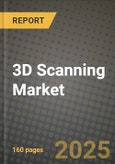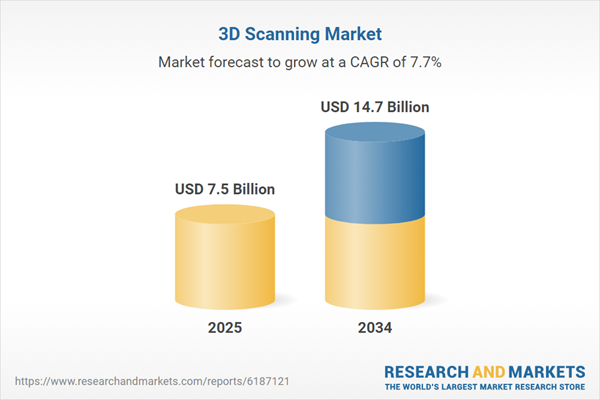The 3D scanning market is experiencing significant growth, driven by the increasing need for accurate and detailed digital representations of physical objects. This market encompasses a range of technologies, including structured light scanning, laser scanning, and photogrammetry, used to capture the shape and dimensions of objects or environments. Applications span diverse sectors such as manufacturing, healthcare, architecture, cultural heritage preservation, and entertainment. 3D scanning enables reverse engineering, quality control, rapid prototyping, and the creation of virtual models for various purposes, significantly improving efficiency and accuracy compared to traditional measurement methods.
The market is characterized by continuous technological advancements, with a focus on improving scanning speed, accuracy, and portability. Innovations in sensor technology, data processing algorithms, and software integration are driving the development of more versatile and user-friendly 3D scanners. The integration of artificial intelligence (AI) and machine learning (ML) is also enhancing the capabilities of 3D scanning, enabling automated data processing, object recognition, and defect detection. Furthermore, the increasing availability of affordable handheld and mobile 3D scanners is expanding the market to a wider range of users, including small businesses and individual consumers. Cloud-based platforms for 3D data storage and collaboration are also facilitating the sharing and utilization of scanned data.
Geographically, the 3D scanning market is expanding globally, with significant activity in North America, Europe, and Asia-Pacific. Developed regions are leading the way in technology adoption and innovation, driven by their advanced manufacturing sectors and research capabilities. Emerging economies are also showing increasing interest in 3D scanning, driven by the need for industrial modernization and infrastructure development. The market's future is promising, with continuous advancements and increasing adoption expected to transform various industries and applications.
Key Insights: 3D Scanning Market
Increased Use of Handheld and Mobile Scanners: Growing adoption of portable 3D scanners for on-site data capture and ease of use.Integration of AI and Machine Learning: Enhanced data processing and object recognition through AI and ML algorithms.
Cloud-Based 3D Data Management: Increasing use of cloud platforms for storing, sharing, and collaborating on 3D scanned data.
Real-Time 3D Scanning: Development of real-time 3D scanning systems for dynamic and interactive applications.
Advanced Photogrammetry Techniques: Improved accuracy and efficiency of photogrammetry through advancements in image processing and software.
Demand for Accurate Digitalization: Increasing need for precise digital representations of physical objects for reverse engineering, quality control, and virtual modeling.
Efficiency and Productivity Gains: 3D scanning significantly reduces measurement time and improves accuracy compared to traditional methods.
Cost Reduction: 3D scanning can reduce costs associated with prototyping, manufacturing, and quality control.
Expanding Applications Across Industries: Growing adoption of 3D scanning in diverse sectors, including manufacturing, healthcare, architecture, and entertainment.
Technological Advancements: Continuous improvements in scanning technology, software, and data processing capabilities.
High Initial Investment Costs: The cost of high-end 3D scanning equipment and software can be significant.
Data Processing and Management: Processing and managing large 3D datasets can be challenging and time-consuming.
Accuracy and Resolution Limitations: Achieving high accuracy and resolution for complex or reflective objects can be difficult.
Environmental Factors: Environmental factors such as lighting, temperature, and humidity can affect scanning accuracy.
Lack of Standardization: The absence of standardized data formats and protocols can hinder interoperability and data exchange.
3D Scanning Market Segmentation
By Type
- Optical Scanner
- Laser Scanner
- Structured Light Scanner
By Offering
- Hardware
- Software
- Services
By Application
- Entertainment and Media
- Aerospace and Defense
- Healthcare
- Civil and Architecture
- Industrial Manufacturing
- Other Applications
Key Companies Analysed
- Carl Zeiss AG
- Konica Minolta Inc.
- Hexagon AB
- Wayland Additive Ltd.
- Autodesk Inc.
- Nikon Corporation
- Trimble Inc.
- Topcon Corporation
- Jenoptik AG
- 3D Systems Corporation
- FARO Technologies Inc.
- Mimetrik Solutions Limited
- Path Robotics Inc.
- Maptek Pty Ltd.
- Creaform Inc.
- CyberOptics Corporation
- Blickfeld GmbH
- Artec 3D
- Scantech International Pty Ltd.
- InspecVision Ltd.
- Skycatch Inc.
- ScanLAB Projects Ltd.
- 3D Digital Corporation
- ShapeGrabber Inc.
- Imerso AS
- OR3D Ltd.
- Astrivis Ltd.
- Nanosurf AG
- Direct Dimensions Inc.
- GOM GmbH
3D Scanning Market Analytics
The report employs rigorous tools, including Porter’s Five Forces, value chain mapping, and scenario-based modeling, to assess supply-demand dynamics. Cross-sector influences from parent, derived, and substitute markets are evaluated to identify risks and opportunities. Trade and pricing analytics provide an up-to-date view of international flows, including leading exporters, importers, and regional price trends.Macroeconomic indicators, policy frameworks such as carbon pricing and energy security strategies, and evolving consumer behavior are considered in forecasting scenarios. Recent deal flows, partnerships, and technology innovations are incorporated to assess their impact on future market performance.
3D Scanning Market Competitive Intelligence
The competitive landscape is mapped through proprietary frameworks, profiling leading companies with details on business models, product portfolios, financial performance, and strategic initiatives. Key developments such as mergers & acquisitions, technology collaborations, investment inflows, and regional expansions are analyzed for their competitive impact. The report also identifies emerging players and innovative startups contributing to market disruption.Regional insights highlight the most promising investment destinations, regulatory landscapes, and evolving partnerships across energy and industrial corridors.
Countries Covered
- North America - 3D Scanning market data and outlook to 2034
- United States
- Canada
- Mexico
- Europe - 3D Scanning market data and outlook to 2034
- Germany
- United Kingdom
- France
- Italy
- Spain
- BeNeLux
- Russia
- Sweden
- Asia-Pacific - 3D Scanning market data and outlook to 2034
- China
- Japan
- India
- South Korea
- Australia
- Indonesia
- Malaysia
- Vietnam
- Middle East and Africa - 3D Scanning market data and outlook to 2034
- Saudi Arabia
- South Africa
- Iran
- UAE
- Egypt
- South and Central America - 3D Scanning market data and outlook to 2034
- Brazil
- Argentina
- Chile
- Peru
Research Methodology
This study combines primary inputs from industry experts across the 3D Scanning value chain with secondary data from associations, government publications, trade databases, and company disclosures. Proprietary modeling techniques, including data triangulation, statistical correlation, and scenario planning, are applied to deliver reliable market sizing and forecasting.Key Questions Addressed
- What is the current and forecast market size of the 3D Scanning industry at global, regional, and country levels?
- Which types, applications, and technologies present the highest growth potential?
- How are supply chains adapting to geopolitical and economic shocks?
- What role do policy frameworks, trade flows, and sustainability targets play in shaping demand?
- Who are the leading players, and how are their strategies evolving in the face of global uncertainty?
- Which regional “hotspots” and customer segments will outpace the market, and what go-to-market and partnership models best support entry and expansion?
- Where are the most investable opportunities - across technology roadmaps, sustainability-linked innovation, and M&A - and what is the best segment to invest over the next 3-5 years?
Your Key Takeaways from the 3D Scanning Market Report
- Global 3D Scanning market size and growth projections (CAGR), 2024-2034
- Impact of Russia-Ukraine, Israel-Palestine, and Hamas conflicts on 3D Scanning trade, costs, and supply chains
- 3D Scanning market size, share, and outlook across 5 regions and 27 countries, 2023-2034
- 3D Scanning market size, CAGR, and market share of key products, applications, and end-user verticals, 2023-2034
- Short- and long-term 3D Scanning market trends, drivers, restraints, and opportunities
- Porter’s Five Forces analysis, technological developments, and 3D Scanning supply chain analysis
- 3D Scanning trade analysis, 3D Scanning market price analysis, and 3D Scanning supply/demand dynamics
- Profiles of 5 leading companies - overview, key strategies, financials, and products
- Latest 3D Scanning market news and developments
Additional Support
With the purchase of this report, you will receive:- An updated PDF report and an MS Excel data workbook containing all market tables and figures for easy analysis.
- 7-day post-sale analyst support for clarifications and in-scope supplementary data, ensuring the deliverable aligns precisely with your requirements.
- Complimentary report update to incorporate the latest available data and the impact of recent market developments.
This product will be delivered within 1-3 business days.
Table of Contents
Companies Mentioned
- Carl Zeiss AG
- Konica Minolta Inc.
- Hexagon AB
- Wayland Additive Ltd.
- Autodesk Inc.
- Nikon Corporation
- Trimble Inc.
- Topcon Corporation
- Jenoptik AG
- 3D Systems Corporation
- FARO Technologies Inc.
- Mimetrik Solutions Limited
- Path Robotics Inc.
- Maptek Pty Ltd.
- Creaform Inc.
- CyberOptics Corporation
- Blickfeld GmbH
- Artec 3D
- Scantech International Pty Ltd.
- InspecVision Ltd.
- Skycatch Inc.
- ScanLAB Projects Ltd.
- 3D Digital Corporation
- ShapeGrabber Inc.
- Imerso AS
- OR3D Ltd.
- Astrivis Ltd.
- Nanosurf AG
- Direct Dimensions Inc.
- GOM GmbH
Table Information
| Report Attribute | Details |
|---|---|
| No. of Pages | 160 |
| Published | October 2025 |
| Forecast Period | 2025 - 2034 |
| Estimated Market Value ( USD | $ 7.5 Billion |
| Forecasted Market Value ( USD | $ 14.7 Billion |
| Compound Annual Growth Rate | 7.7% |
| Regions Covered | Global |
| No. of Companies Mentioned | 30 |









